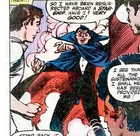
The vampire, Count Dracula.
A vampire is a type of being from mythology of many different races and cultures, including many Human cultures on the planet Earth. Legends have it that the vampire is born of the death of a lifeform, an undead being given the dark purpose of draining the blood and life from others, but with some variations of the tales regarding the true powers and weaknesses and the supernatural origin of vampires. Many microbes and other forms of disease can cause symptoms similar to the characteristics of vampires described in mythology, including some lifeforms across the galaxy that have adapted similar traits as life processes.
The salt vampire of M-113 is so named as a reference to its propensity to shapeshift and lure victims with the intent of draining the salt from their bodies as a vampire would drink blood. Likewise, the vampire cloud that frequented the vicinity of Tycho IV was named because of its life process that depleted the iron-based blood cells of all victims, leaving them completely drained of blood. (ST reference: Star Trek Concordance)
Vampires became popular subjects of more contemporary Earth literature, including adaptations for movies and television entertainment. The story of Count Dracula is a notable example of vampire storytelling. In the 23rd century, Commander Spock of the Federation starship USS Enterprise found 20th century history records that indicated that the subject of the novel Dracula had been a real being who survived several centuries before being defeated. (TNG comic: "The Haunting of Thallus!")
Pavel Chekov, a frequent recipient of medical testing as a young member of Starfleet, suggested that all doctors were vampires. (TOS novel: Uhura's Song)
In an alternate reality, vampire powers had been the subject of experiments on Earth and investigated by a Covert Vampiric Operations group. A CVO vampire named Britt carried a zombie virus and crossed into the Federation's reality on Calibus VII, as well as several other alternate realities. The situation was resolved through the efforts of Rear Admiral James T. Kirk. (TOS - Infestation comics: "Issue 1", "Issue 2")
See also[]
External links[]
- Vampire article at Memory Alpha, the wiki for canon Star Trek.
- Vampire article at Wikipedia, the free encyclopedia.
